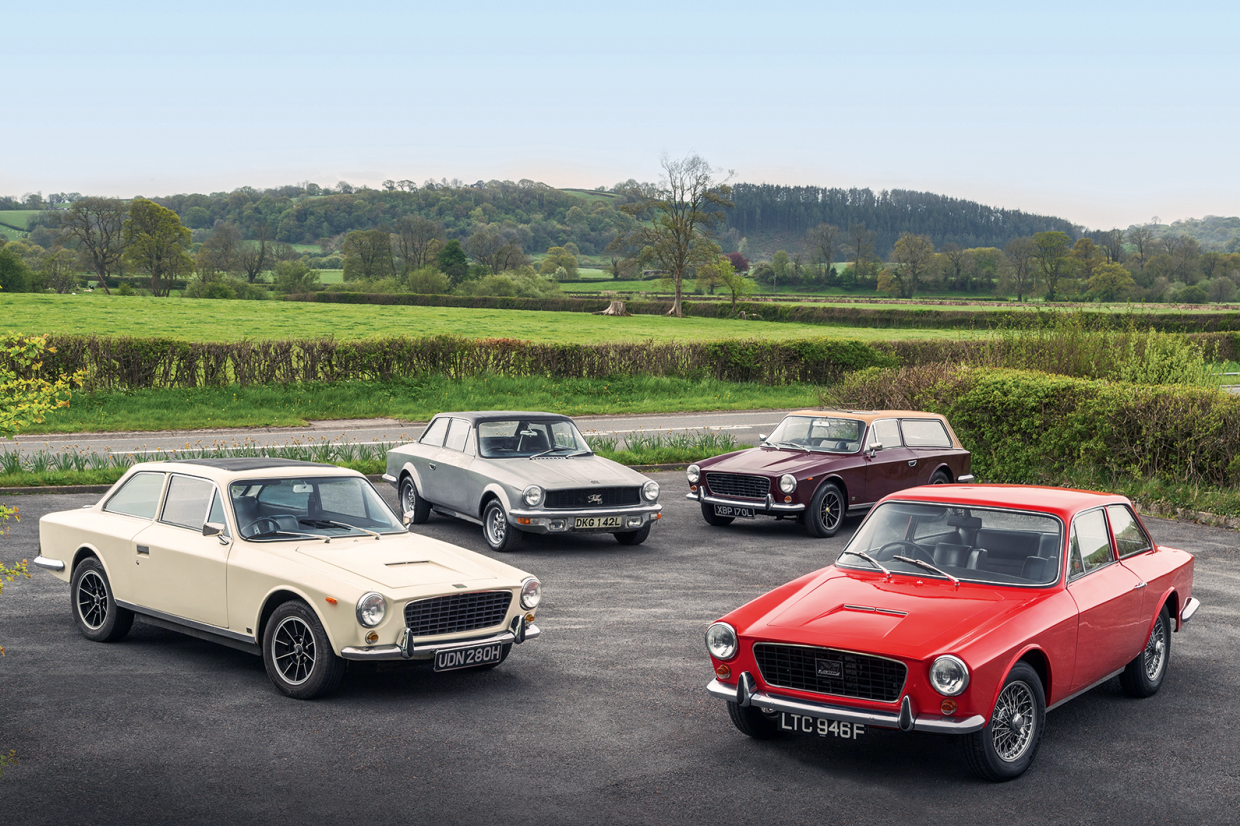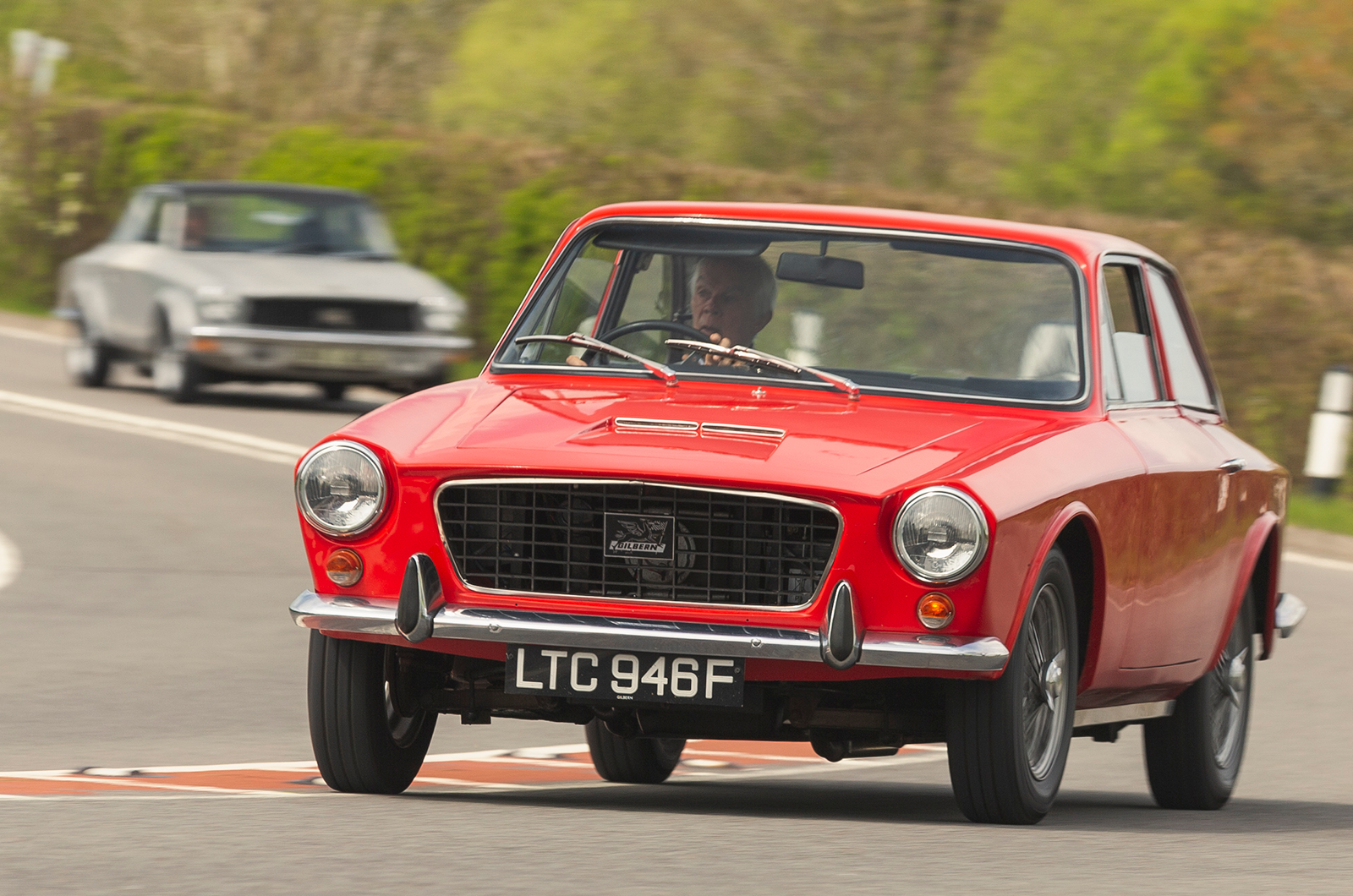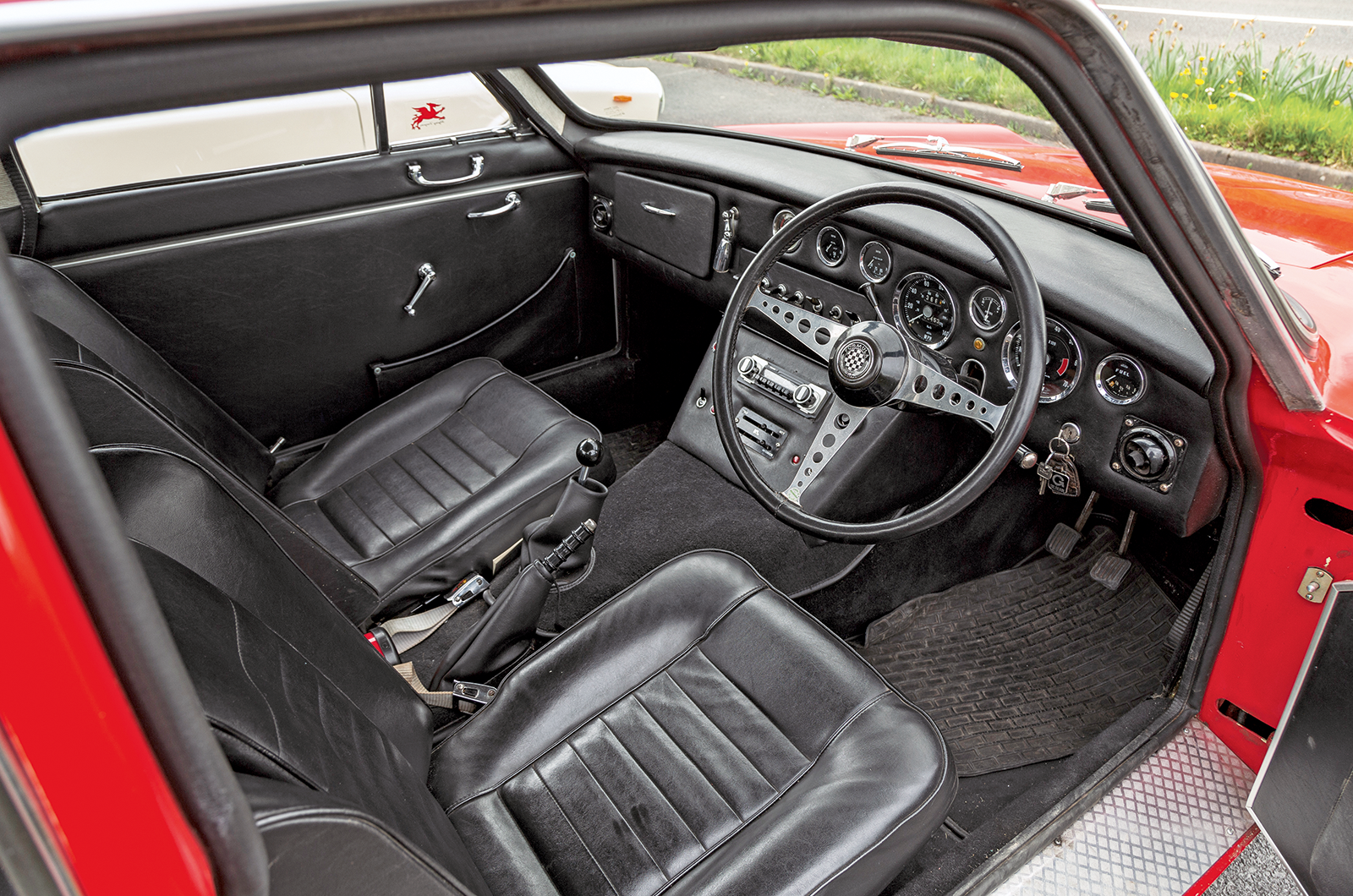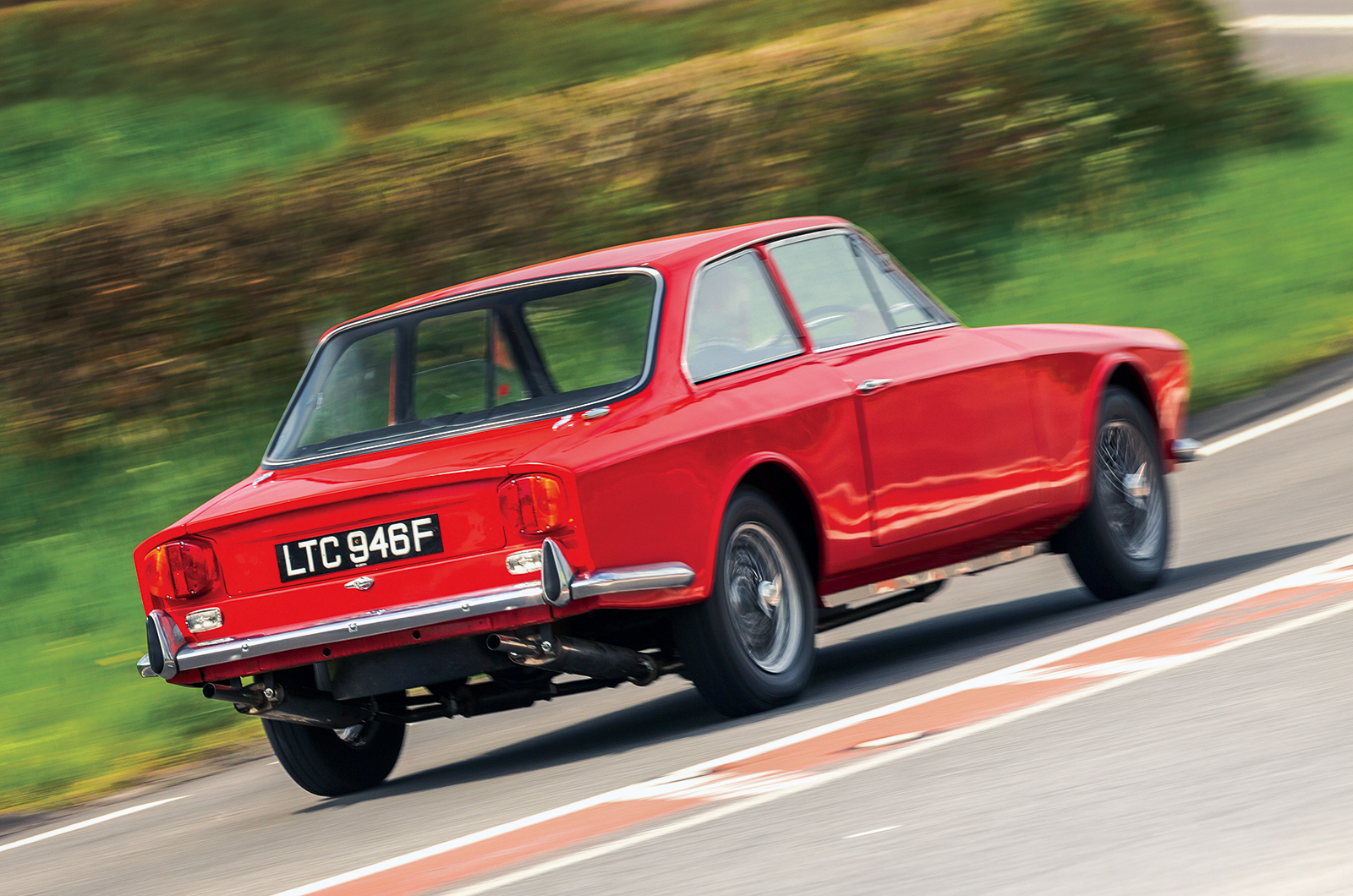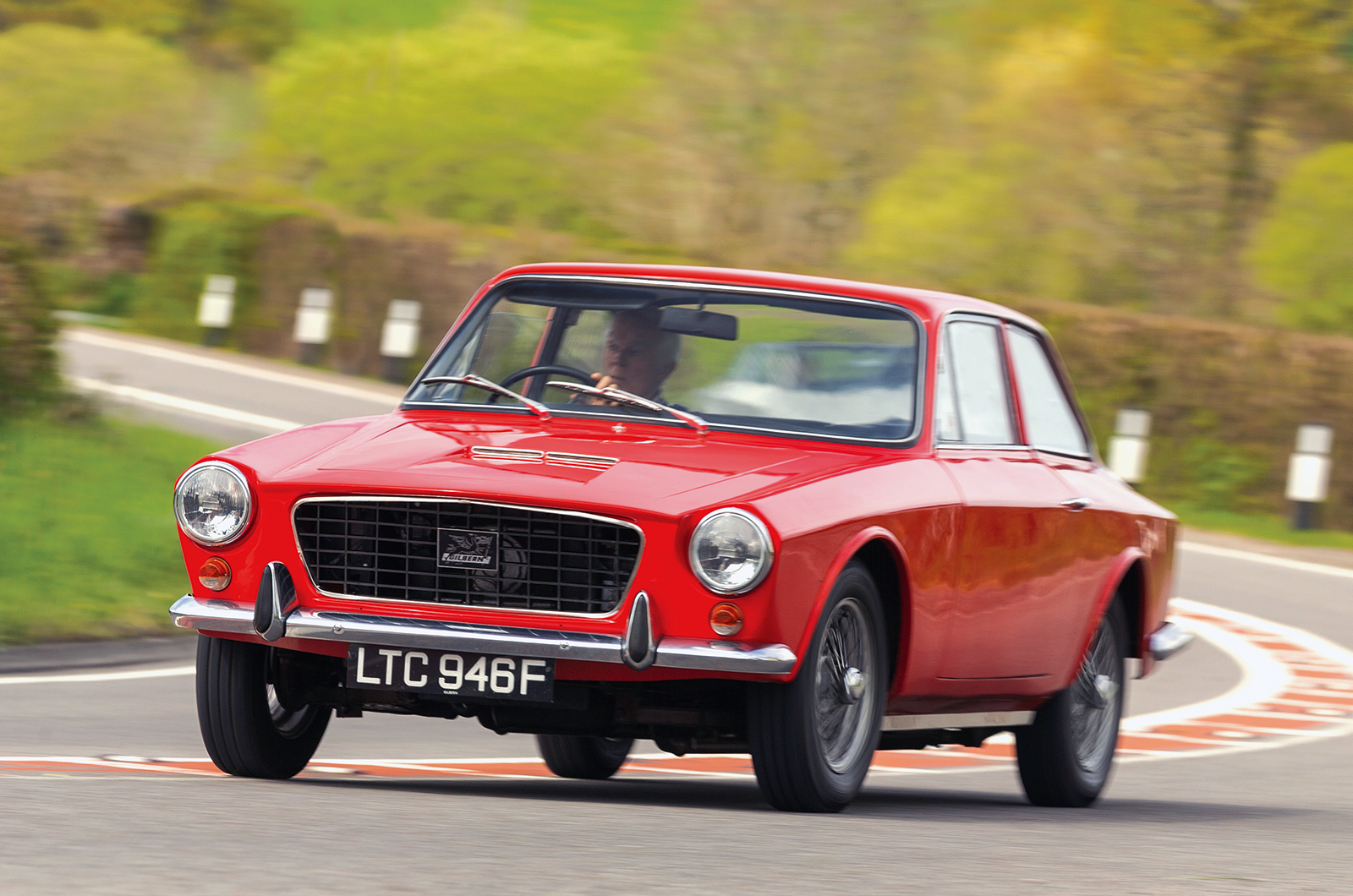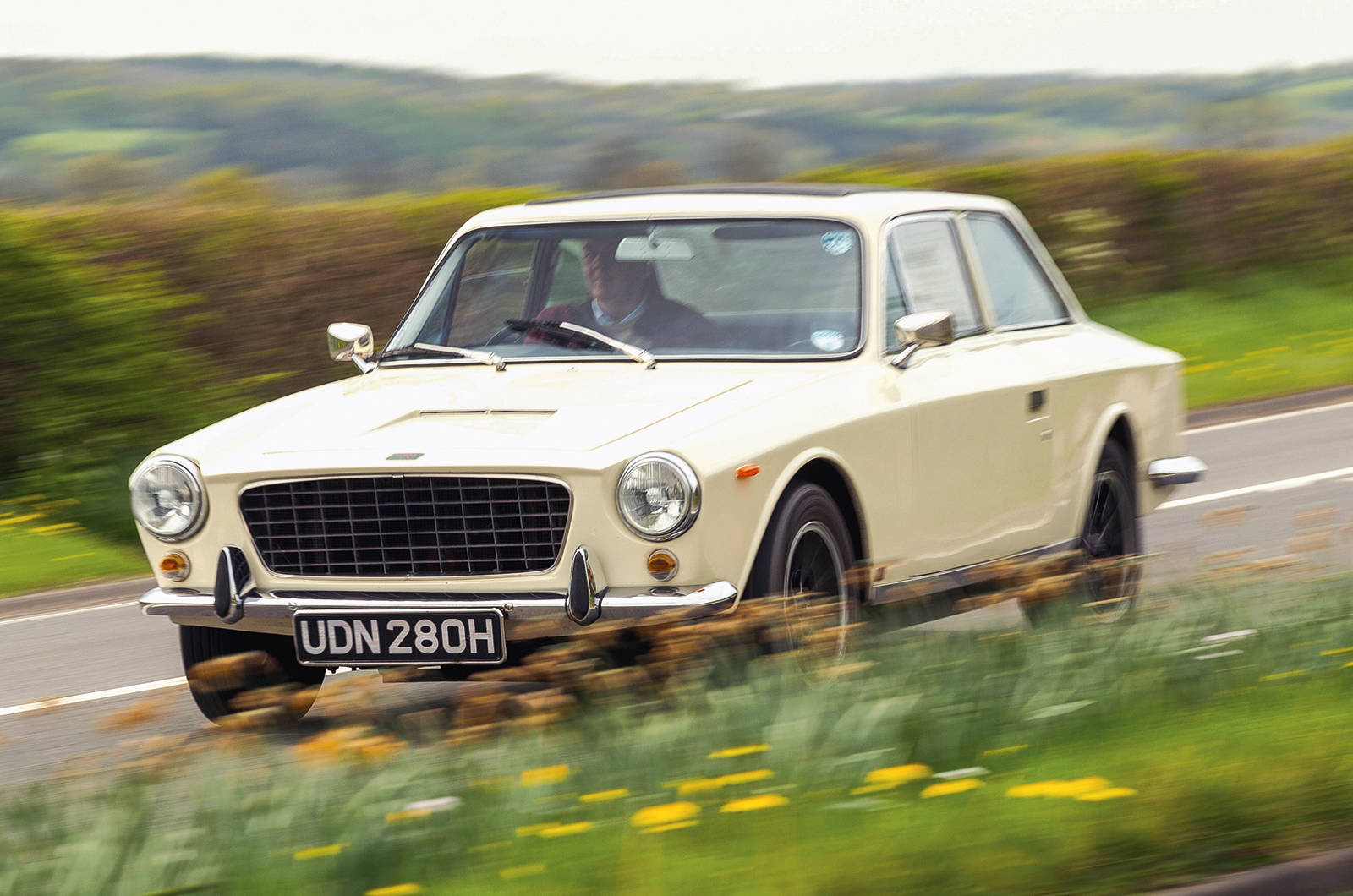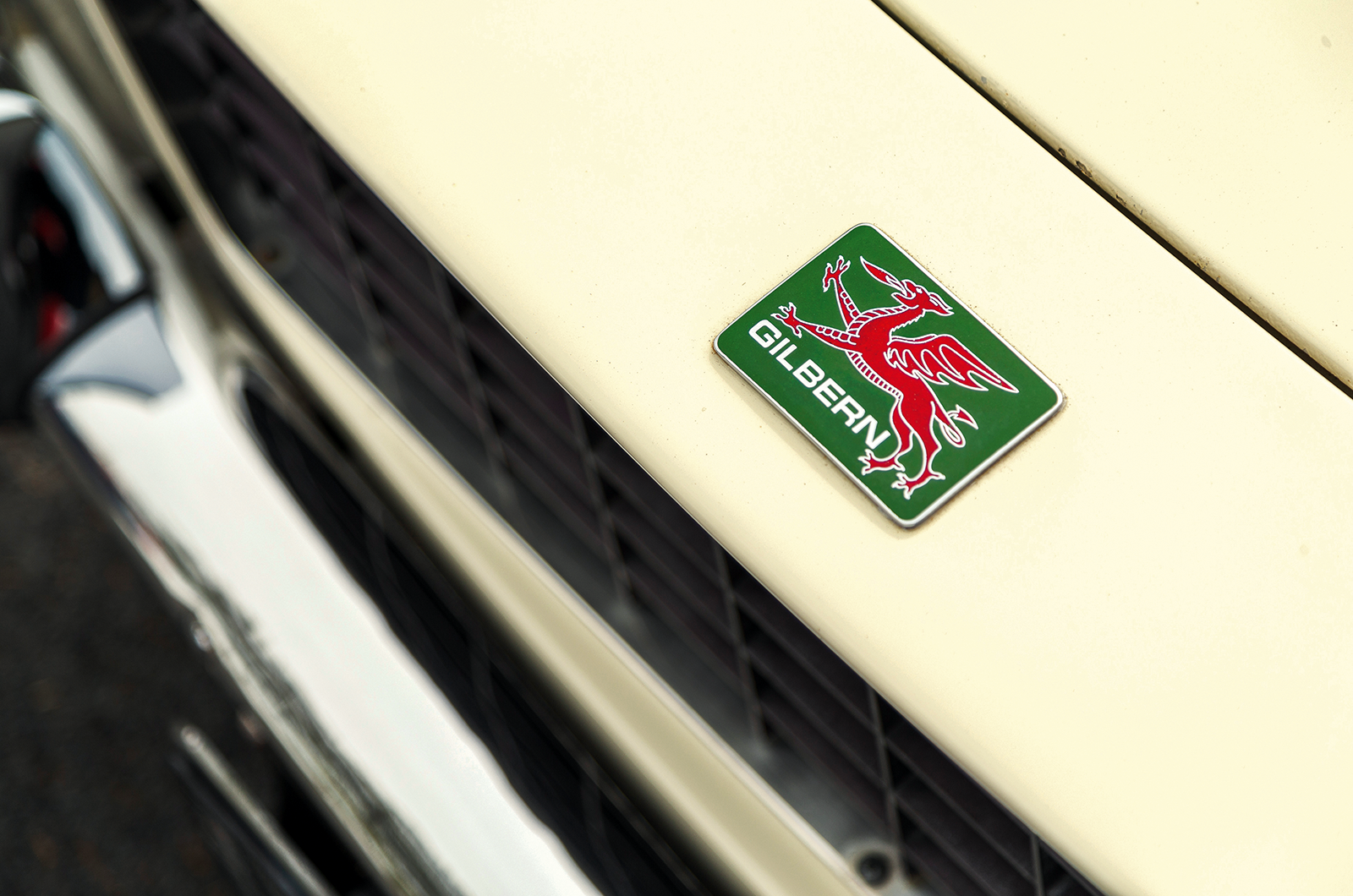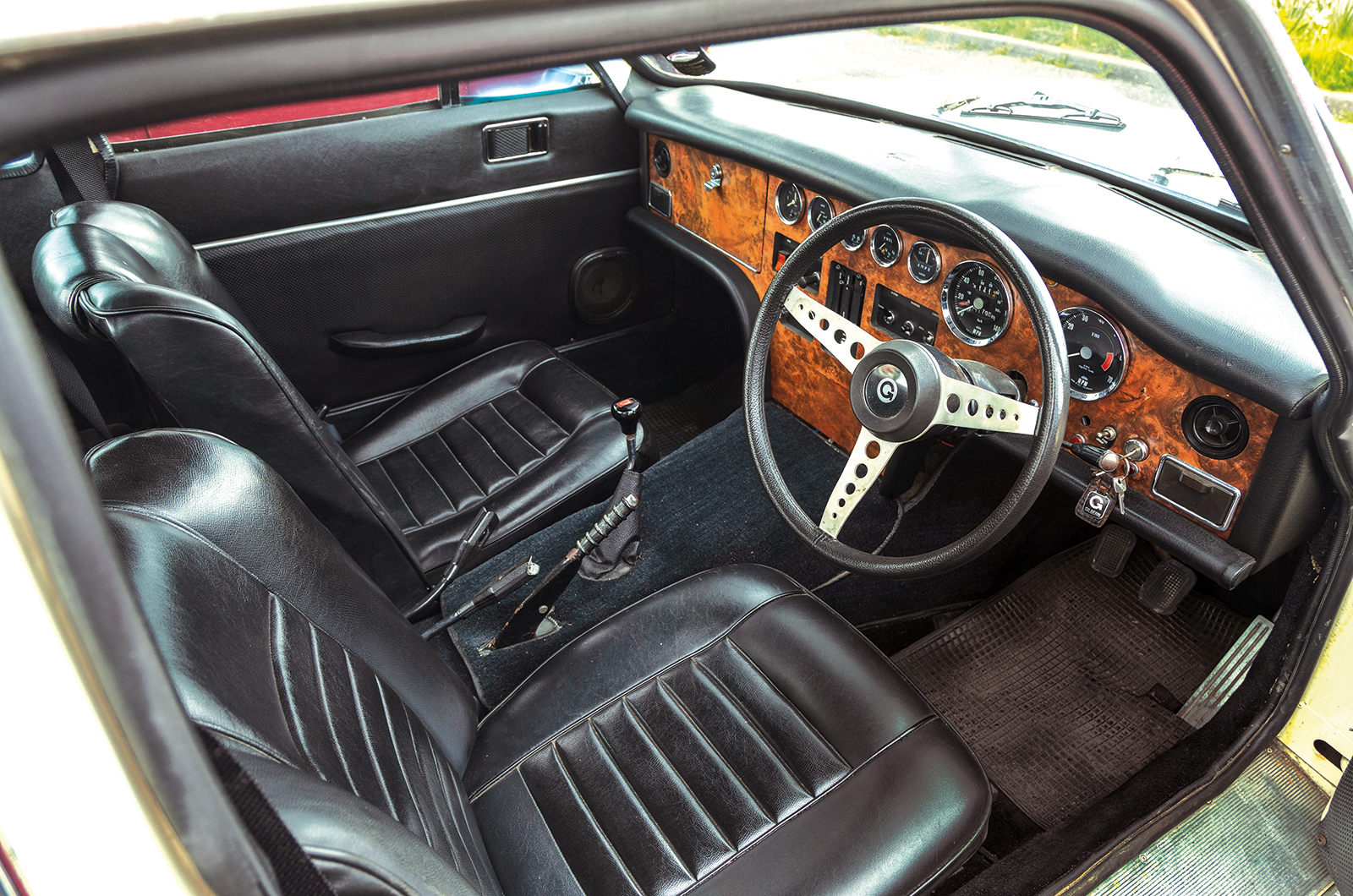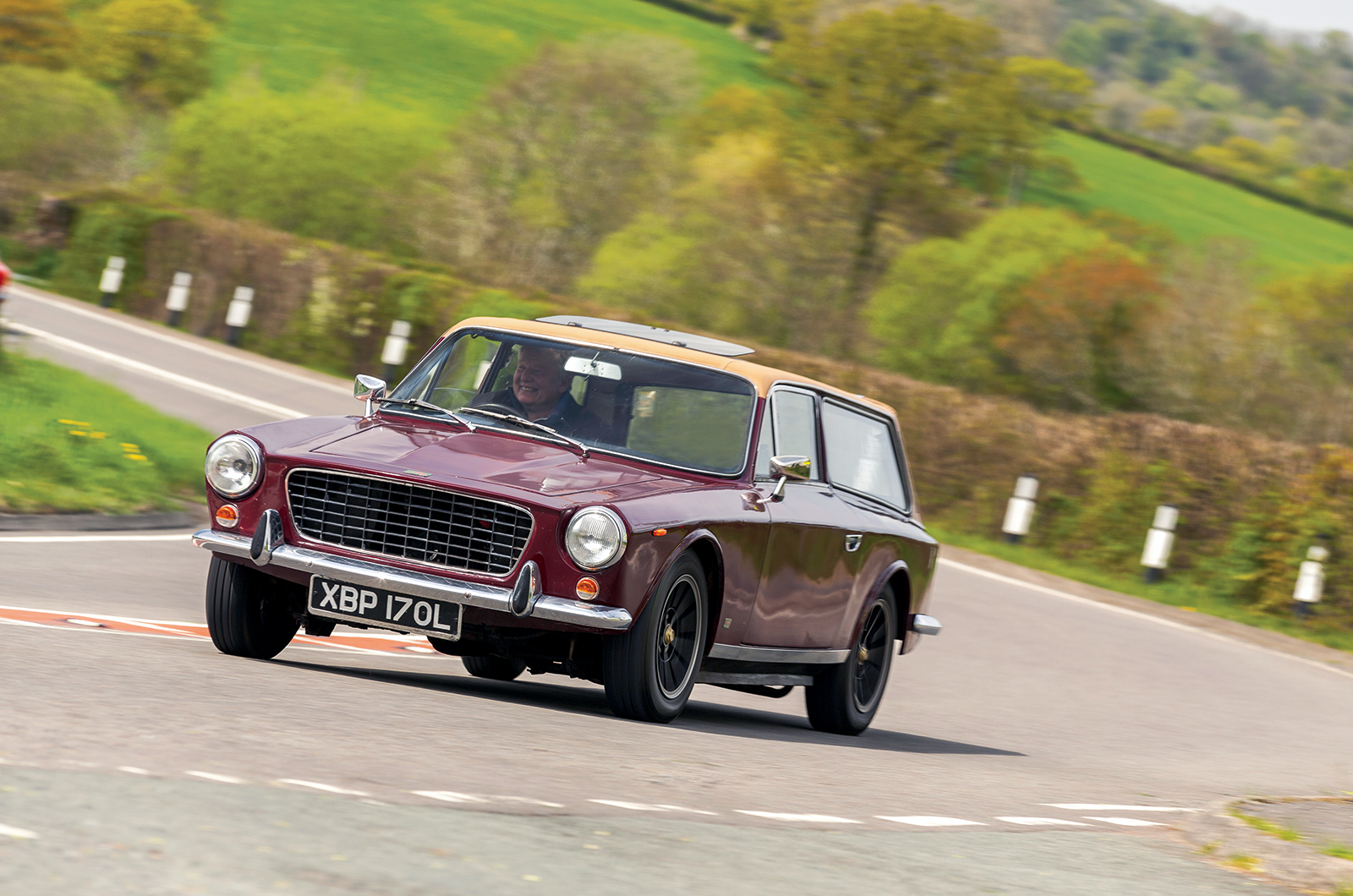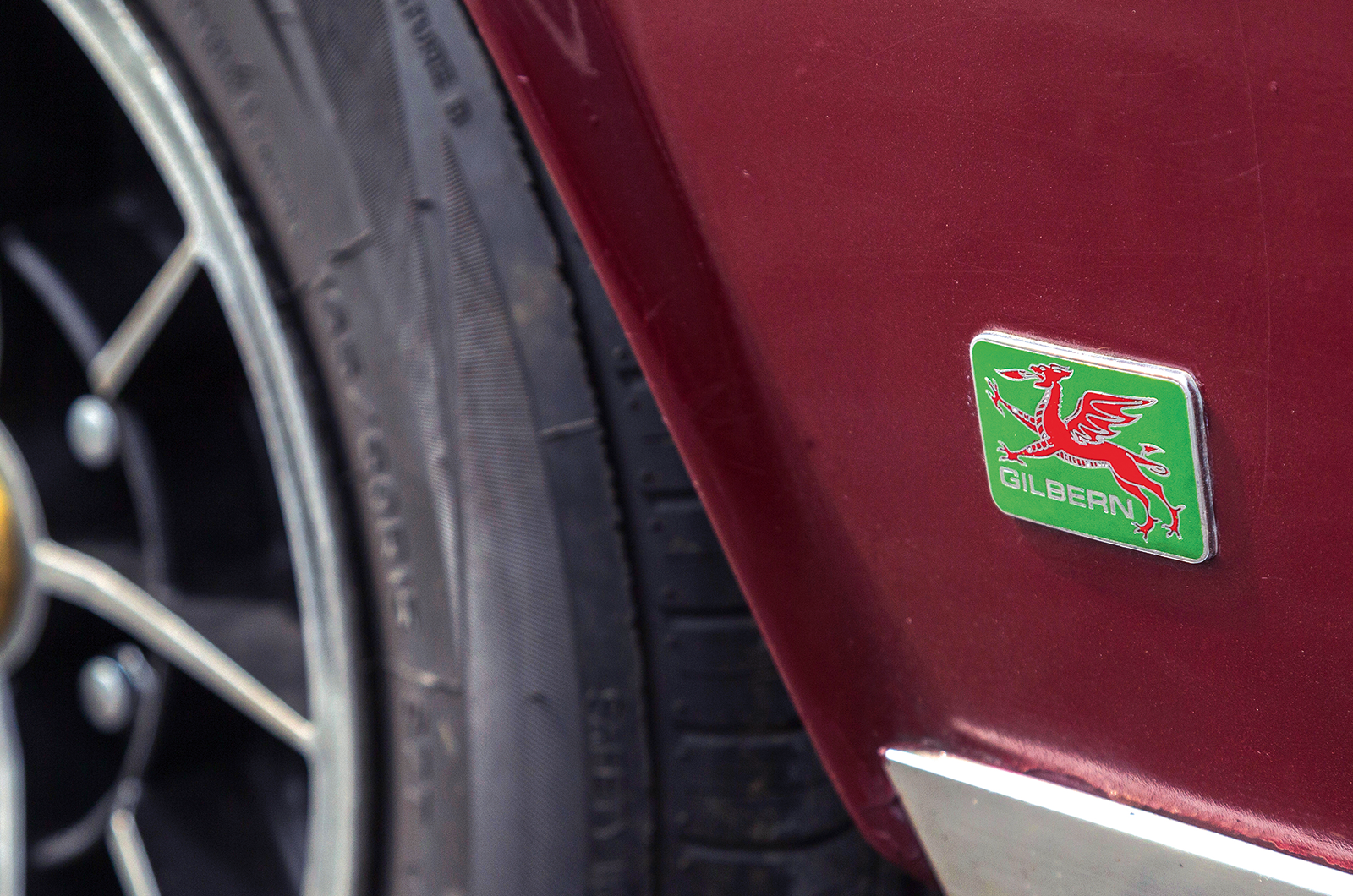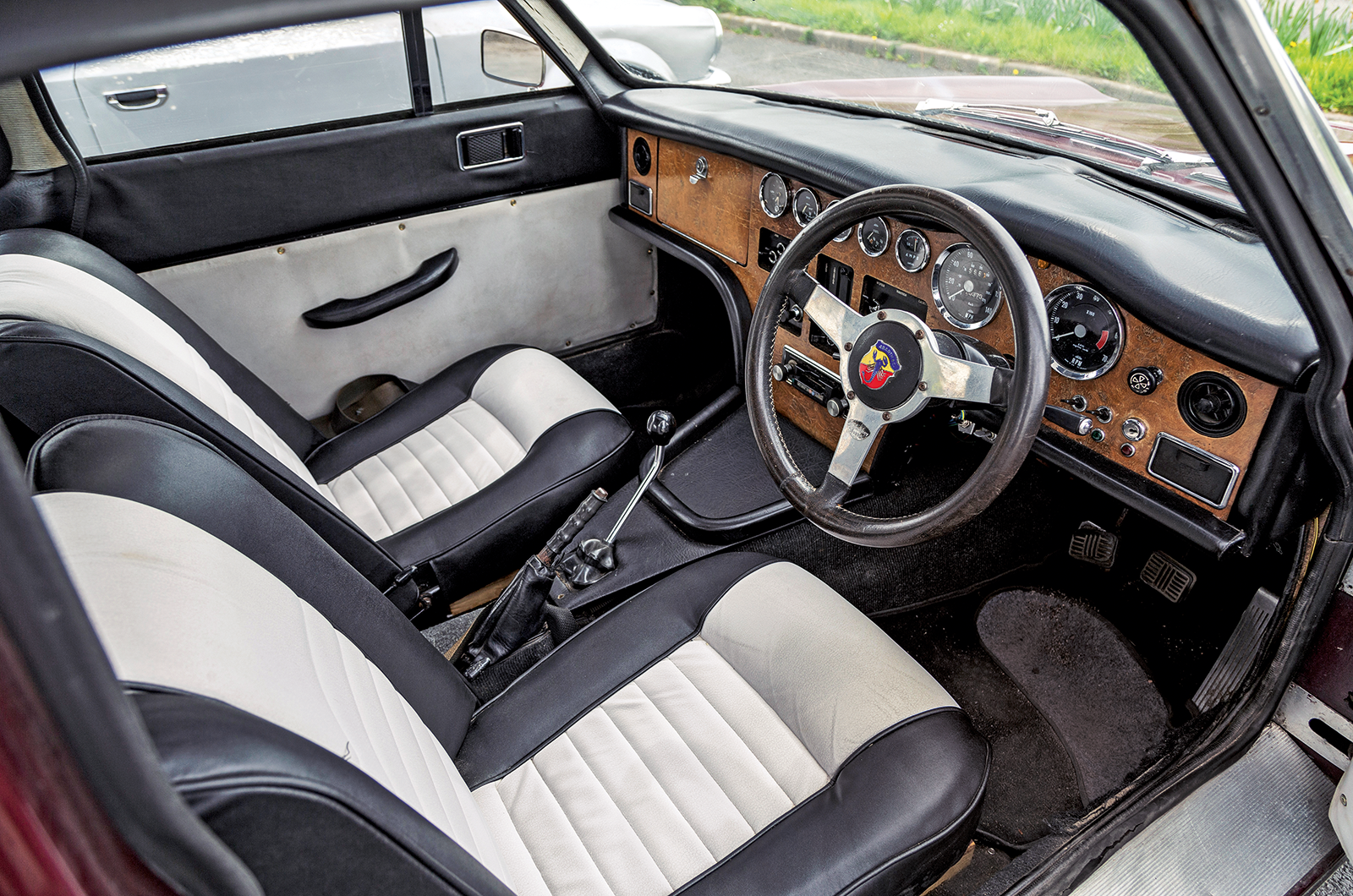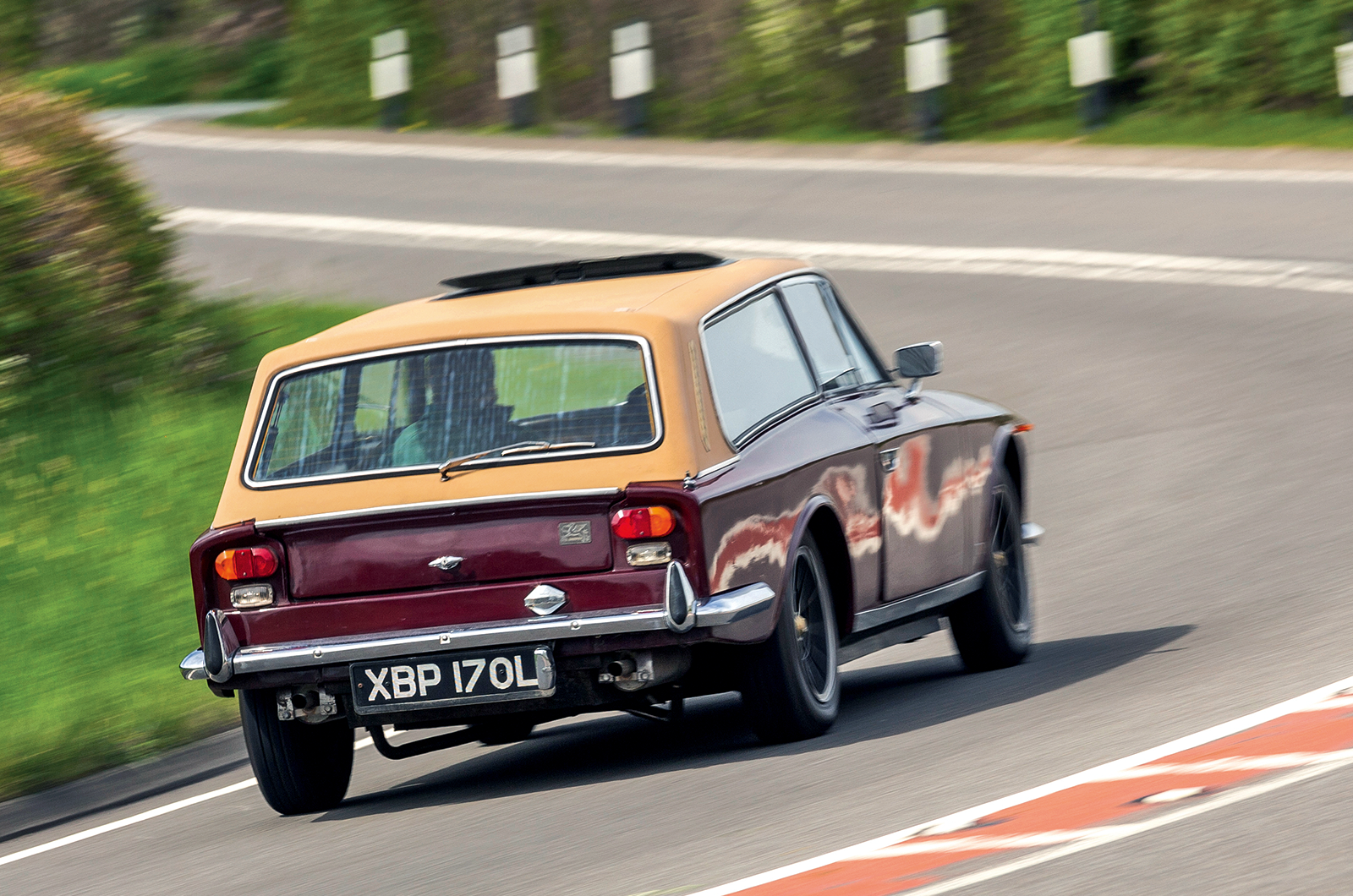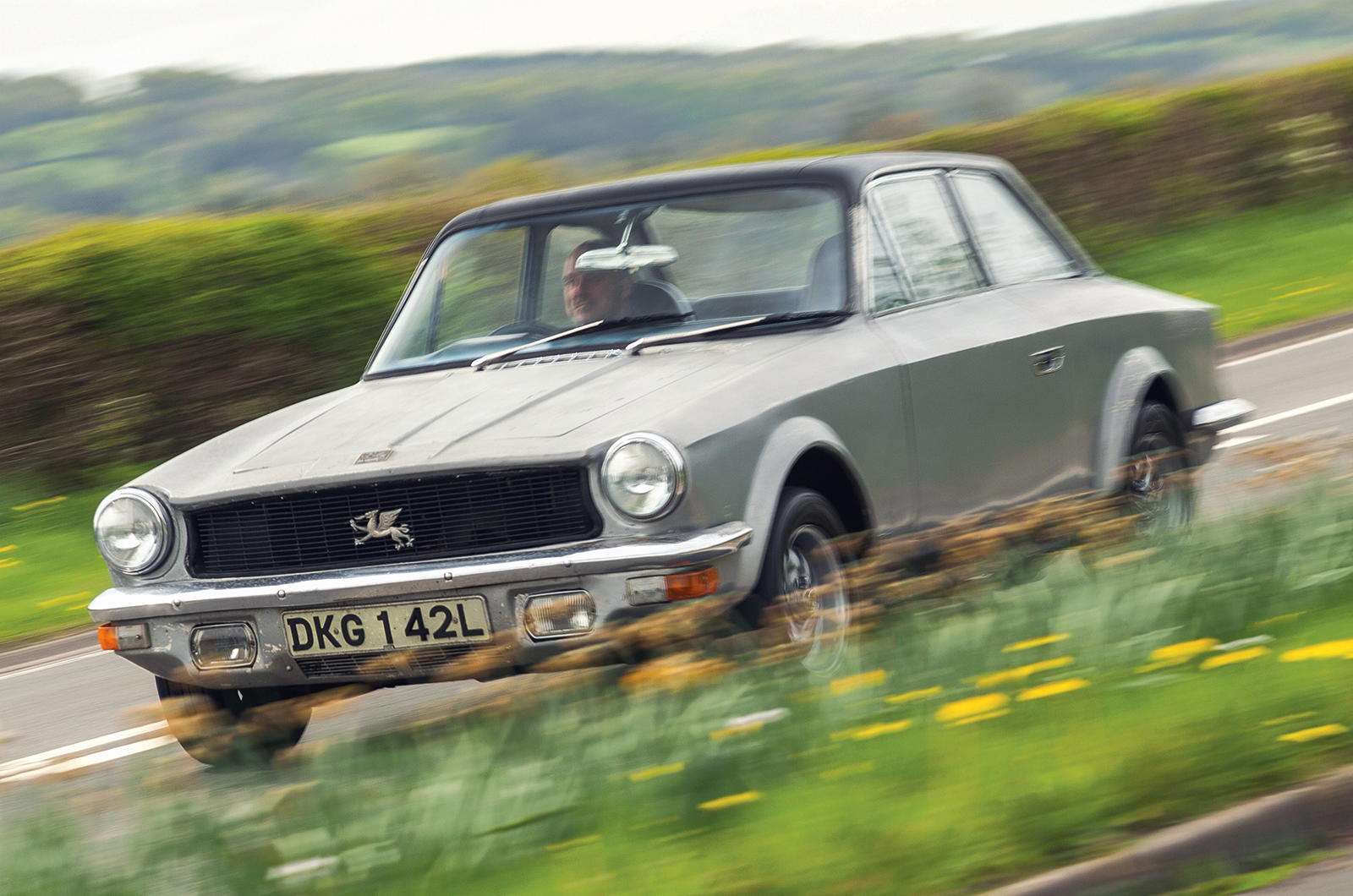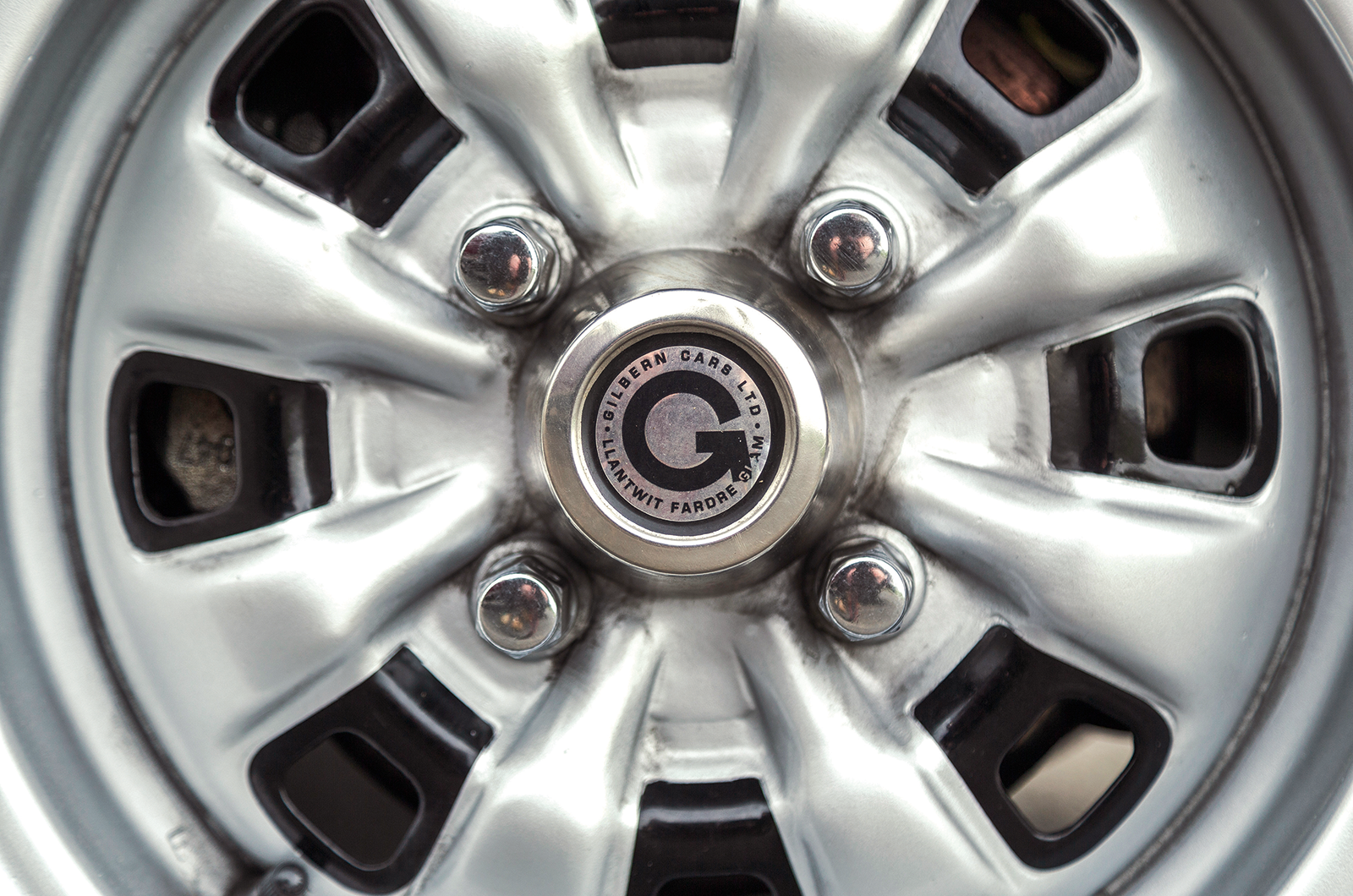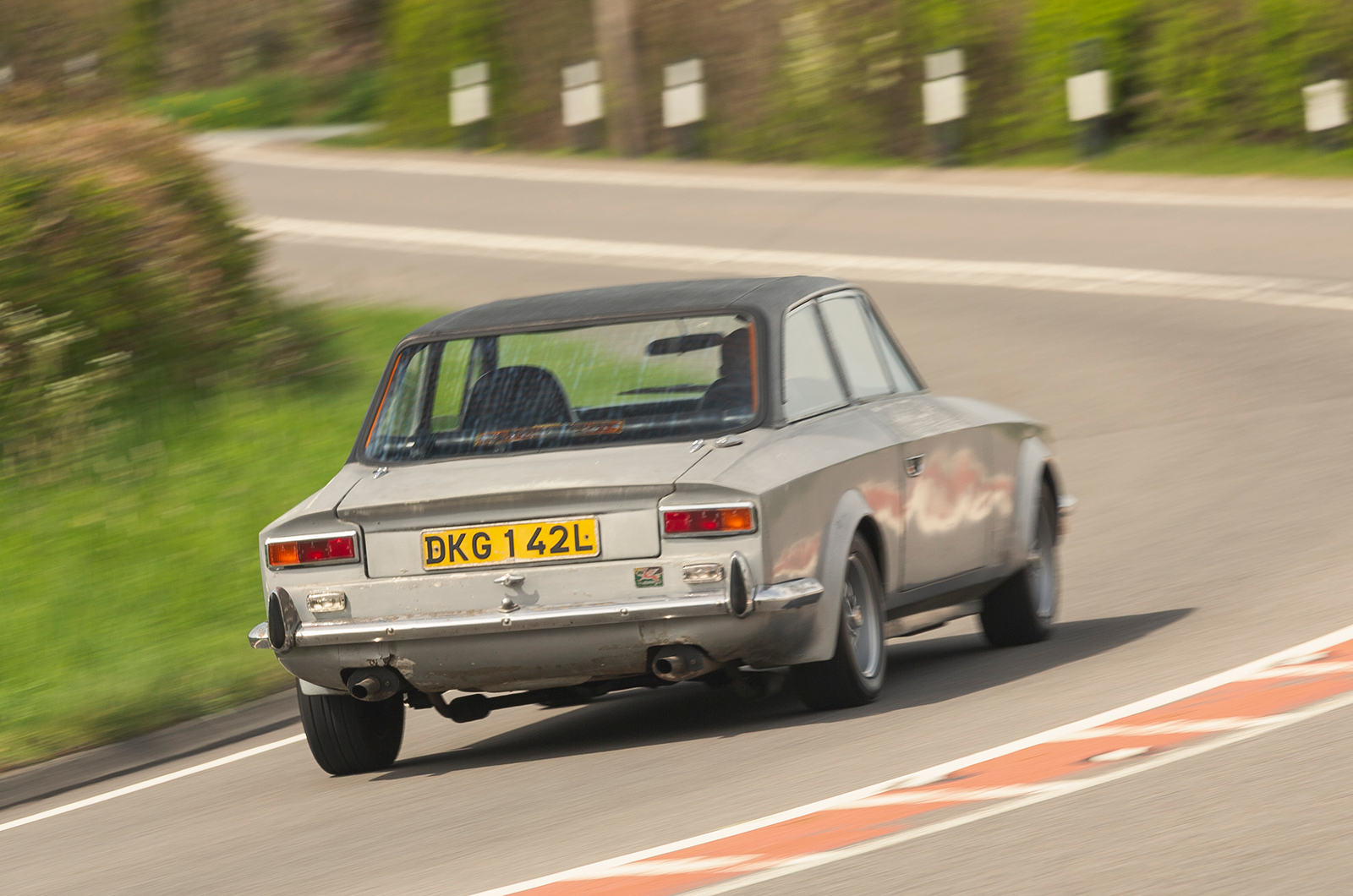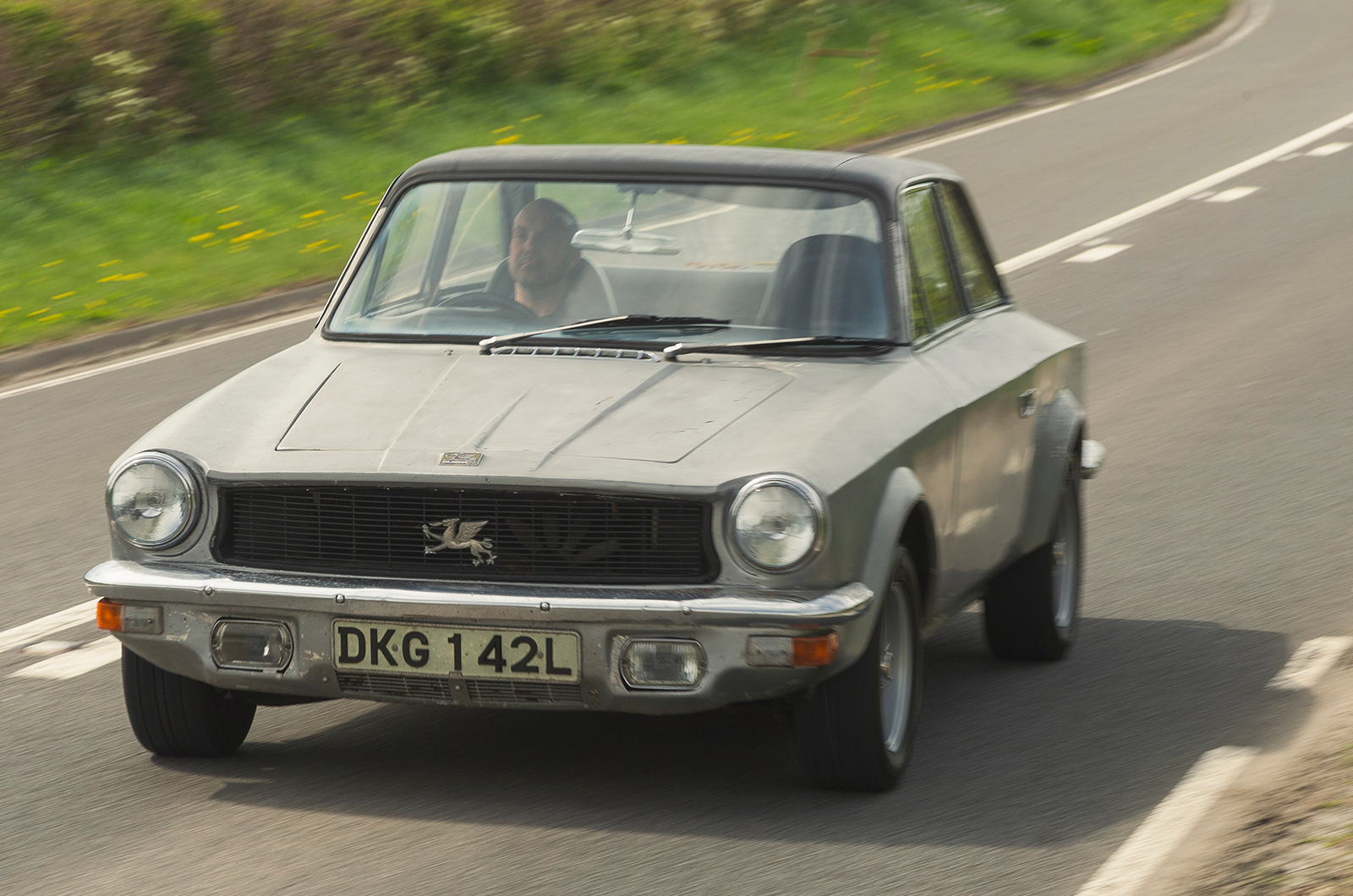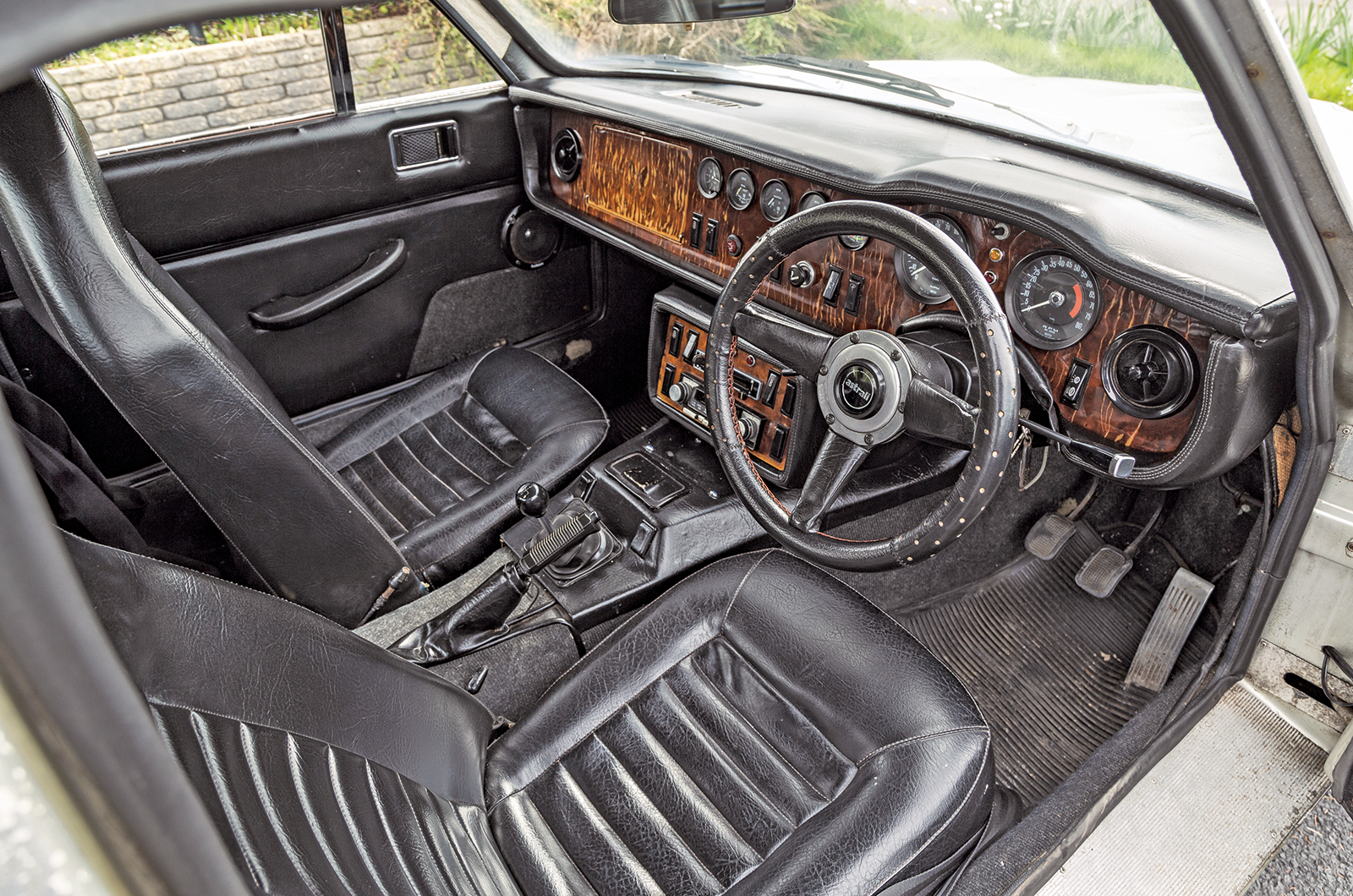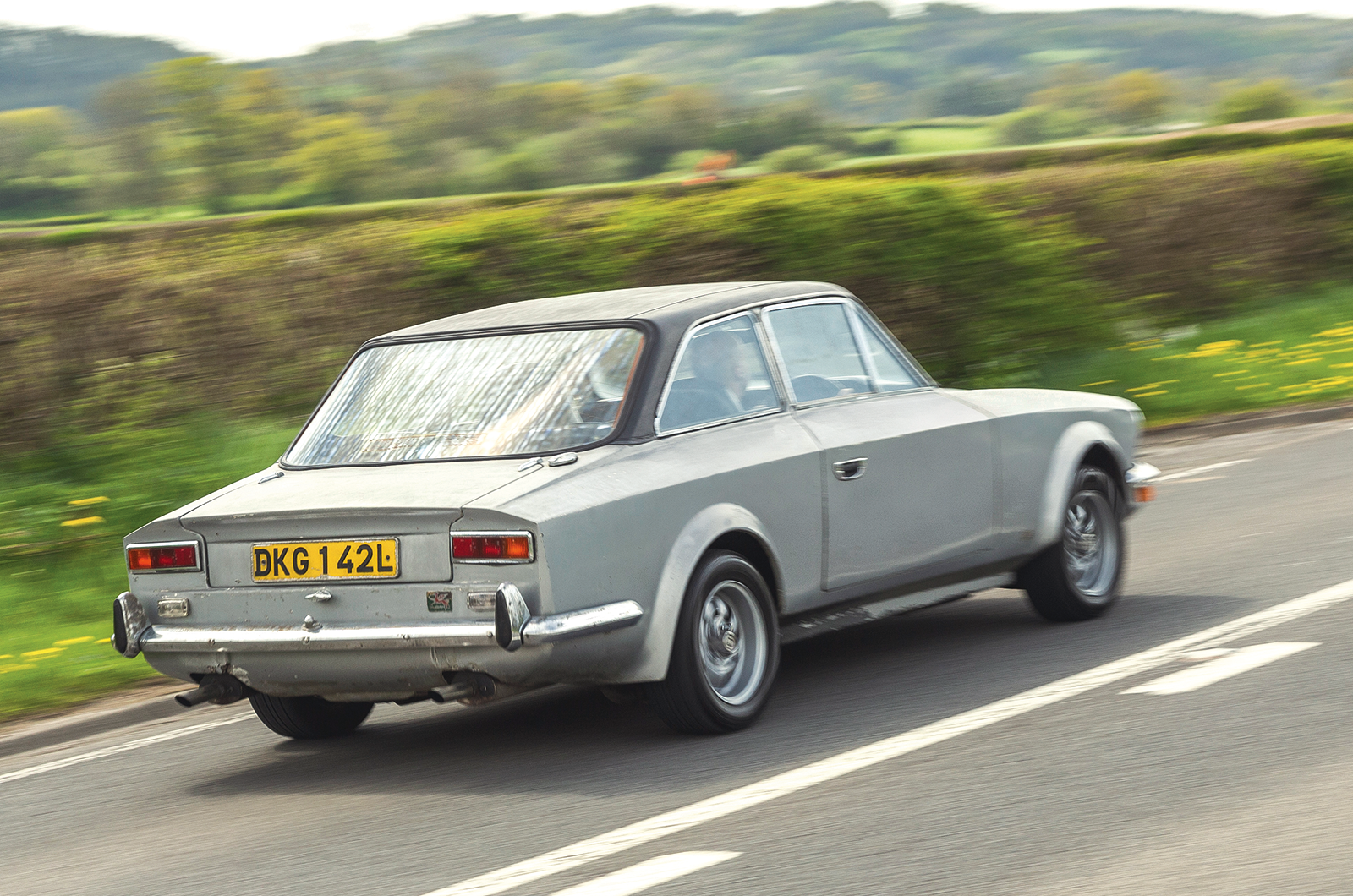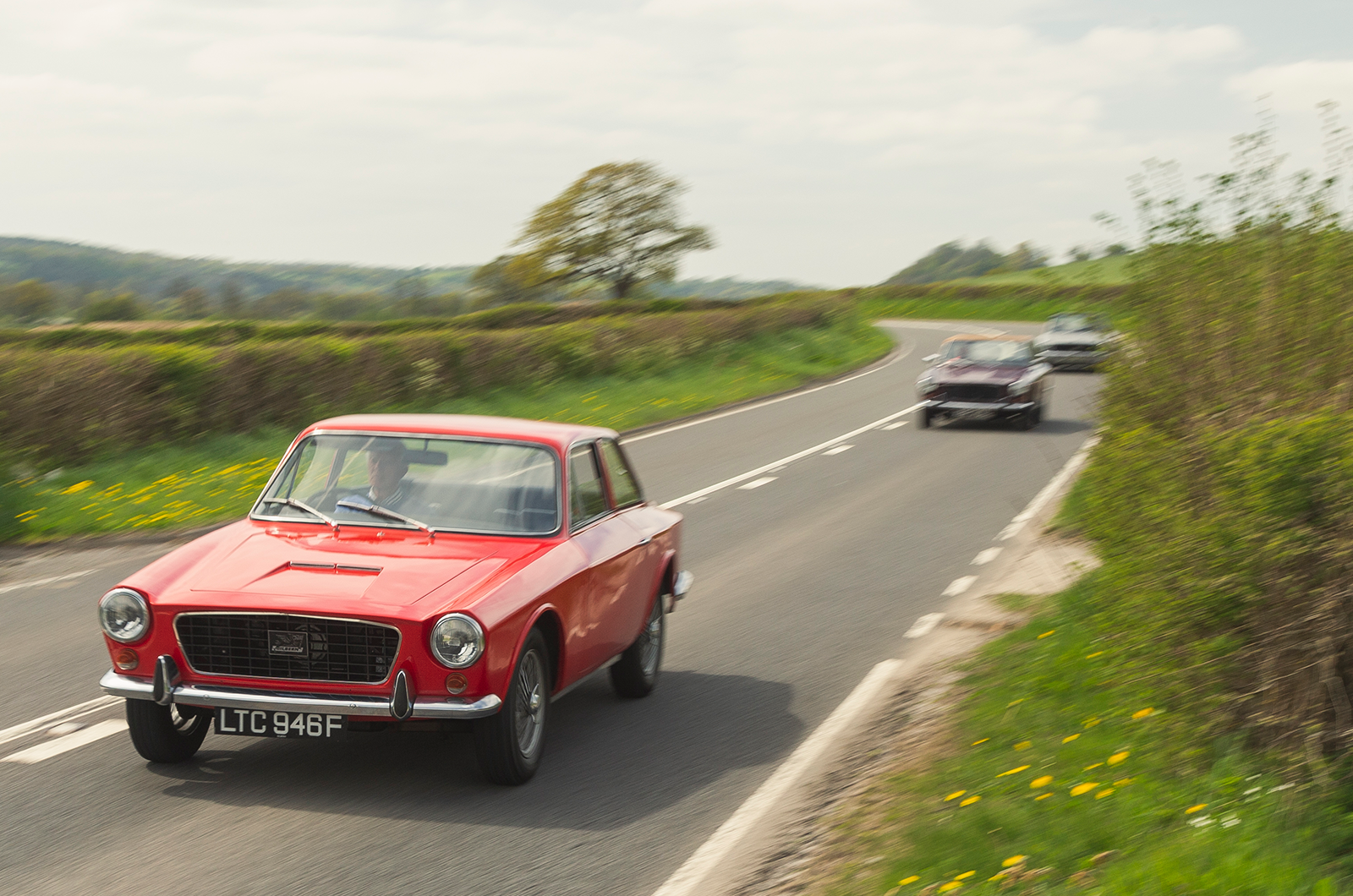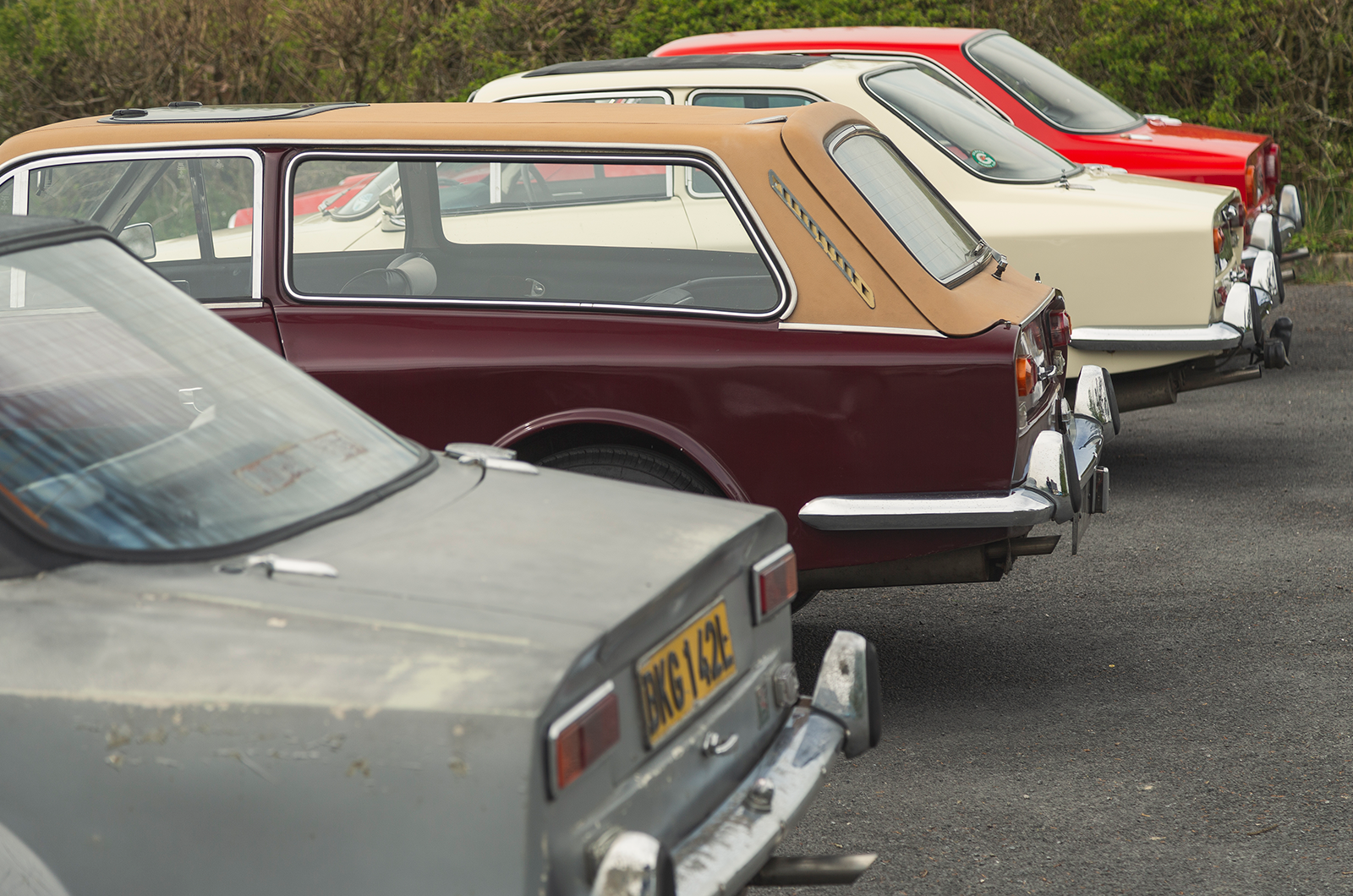There were schemes to market the cars in Europe, America and even the Middle East, but plans for new models – a long-wheelbase Invader and the Maxi-based, mid-engined T11 – were just pipe dreams in the face of rising debts and looming receivership.
This Gilbern’s later retrim reflects the MkII Invader’s two-tone exterior
There were still full order books for the MkIII but, when new investment failed to materialise, the banks could be held off no longer; production ended in March 1974.
Gilberns have always been club-friendly, enthusiast machines (the club was set up in 1969), lending themselves to the sort of tweaks and modifications that suit the whims of keen owners; those who want to use their cars on the road and in competition rather than obsess over originality.
So while the overall survival rate is impressive, original-looking V6 Gilberns – more or less representative of what was bought in period – are few and far between.
The MkII’s profile somewhat echoes the Scimitar GTE
With that in mind, club chairman Brian Gent helped us assemble – in their native South Wales – the group pictured here.
Along with Gent’s white MkI Invader are Wynne Jones’ bright-red Genie, Gareth Francombe’s MkII Invader Estate and the silver MkIII of Mark Jones, proprietor of Gilbern and glassfibre specialist Sporting Classic Marques, based in Carmarthenshire.
Looking at the Genie and the MkI, it suddenly struck me that, as well as having something of the Alfa Romeo 105-series Bertone coupé about it, this four-square, unassuming shape’s true inspiration was probably Vignale’s Maserati Sebring.
The Invader MkIII made use of more Ford parts
The estate looks good from the back, but less happy from the side due to the clumsy, drooping line of the side windows.
There is at least one privately converted Genie estate that uses a more regularly fashioned straight-through sheet of glass that is much more happily resolved.
Even so, as a high-speed GT wagon, the Invader Estate definitely has an appeal, and pairs well with Francombe’s Elan +2, which he thinks is prettier but not so nice to drive as the Invader.
The Invader MkIII’s flared wheelarches house 13in Ford Cortina steel wheels
The MkIII was not Gilbern’s finest hour visually, having something of the feel of an ageing uncle dressing too young in brown flares after the simple, trim 1960s elegance of the ‘big wheel’ Genie/Invader models.
The detailing of the Genie, with its wire wheels and simple leather/cloth dash layout, makes it marginally the more appealing of the early cars.
Owner Jones, who first caught the Gilbern bug as a youngster in the late ’60s when he helped a friend assemble a Genie kit, agrees, pointing out the neatly trimmed door bins, the original, leather-trimmed, alloy-spoked sports wheel and the handsome array of chrome-ringed Smiths instruments that continue the Maserati-inspired theme.
Thankfully, the MkIII Invader keeps the V6’s throaty burble
The wood-veneered MkI and MkII Invaders are much of a muchness inside (all versions have Jensen-like, deeply sculpted individual rear seats), but the MkIII of Mark Jones moves the luxury game on with a padded centre console, matt-black instrument bezels and safety-inspired rocker switches rather than pointy toggles.
As far as driving them goes, the Genie, the early 15in-wheel Invaders and the MkIII all leave you with an impression of compact, lazy muscle that makes fussy gear play and high revving unnecessary, accompanied by an offbeat, throaty V6 burble, lusty pick-up and urgent throttle response.
Good vision past skinny roof pillars is common to all, as is decent wind- and road-noise suppression.
Boosted by a network of 27 dealerships, Gilbern sold 220 Invader MkIIIs
The MkIII, with its lower driving position in high-backed ‘sports’ seats and chunky steering wheel, adds to these virtues with a subtly more refined drivetrain and ride, although none of the Gilberns, despite limited suspension travel, were the expected filling-rattlers along the smooth sections of Welsh A40 on which I tried them.
The flared-arch MkIII has a conventional gearlever rather than the trademark cranked-forward appendage in the earlier models – these instil visions of a hefty, delivery-van shift.
In fact, it has a neater, slicker action than you would expect and – after some minor negotiations over your first third-to-second downchange – you really don’t think about it again.
The Gilbern Invader MkIII’s updated interior features low-slung sports seats
Most of the time you can simply miss gears out, with hardly any effect on the rate of progress, or just play tunes with the overdrive that works on third and top.
This, combined with the flexibility of the V6, tends to disguise the curiously spaced, Zodiac-inspired ratios, with first and second too close and then a big gap between second and third.
You don’t quite expect such compact cars to have such heavy steering – the MkIII’s is a touch lighter – but it’s a fair pay-off for the high-geared directness that allows the Gilberns to carry speed through curves neatly against modest understeer and strong castor return.
The Ford V6-engined Invader MkIII boasts smooth torque and nifty throttle response
Smooth torque, nifty throttle response and faithfully accurate helms combine with a hard-to-define, seat-of-the pants feel that promises forgiving on-the-limit characteristics and all-round happy endings.
We tend to group all the Ford V6-engined glassfibre specialist sports cars of the late ’60s onwards together, but they are not quite such a homogenous group as you might think.
In some ways, Gilberns resist attempts at labelling.
With four seats and a three-box, saloon-like profile, can a Genie or an Invader really be considered a sports car? Probably not.
The Gilbern Genie (front) and Invaders all benefit from forgiving on-the-limit characteristics
But neither does its appeal chime with the image of suave sophistication – Euro or otherwise – that the letters ‘GT’ tend to conjure, although it goes better than many of that ilk: you can spend quite a lot of money to get a four-seater ’70s coupé with better acceleration than a V6 Gilbern.
There is some merit in invoking the memory of Allard when speaking of these small, big-engined, competition-inclined mongrels.
Their air of rugged individualism almost tempts me to think of them as a kind of Welsh species of Bristol, even if the disparity in detail refinement, and use of materials, is too large to allow that
to stick for long.
The truth is that the Gilbern Genie and Invader, perhaps more fun and easier to own than all of the above, just are what they are.
That should be good enough.
Images: Luc Lacey
Thanks to: the owners and Brian Gent, the Gilbern Owners’ Club Ltd
Factfile
Gilbern Genie & Invader
- Sold/number built 1966-’74/803
- Construction glassfibre body, steel chassis
- Engine all-iron, ohv 2994cc V6, Weber carburettor or fuel injection
- Max power 141bhp @ 4750rpm (injection 165bhp)
- Max torque 181Ib ft @ 3000rpm
- Transmission four-speed manual overdrive, RWD
- Suspension: front independent, by wishbones, anti-roll bar rear live axle, trailing arms, Panhard rod; coils, lever-arm/telescopic dampers f/r
- Steering rack and pinion
- Brakes discs front, drums rear
- Length 13ft 3¼in (4039mm)
- Width 5ft 5in (1651mm)
- Height 4ft 3½-4in (1308-1321mm)
- Wheelbase 7ft 8½in (2356mm)
- Weight 1990-2380Ib (903-1080kg)
- 0-60mph 8.6 secs
- Top speed 120mph
- Mpg 18-22
- Price new £2046 (1966), £2657 (1974)
- Price now £15-20,000*
*Prices correct at date of original publication
READ MORE
Children of the revolution: Deep Sanderson DS301 vs Ogle SX1000 vs Mini Jem vs Unipower GT
Buyer’s guide: Reliant Scimitar GTE
Coupé conundrum: Ford Capri vs Datsun 240Z
Martin Buckley
Senior Contributor, Classic & Sports Car
